Meningitis: A Research Project on Awareness, Symptoms, and Prevention
VerifiedAdded on 2023/06/10
|26
|3968
|464
Project
AI Summary
This research project investigates public awareness of meningitis, exploring its signs, symptoms, preventative measures, and mortality rates. The study collected primary data through a questionnaire administered to 149 participants, focusing on their understanding of meningitis. The research delves into the causes of meningitis, including bacterial and viral infections, and examines the most susceptible age groups. The project also covers the symptoms, long-term impacts, and modes of transmission of meningitis, along with diagnostic and treatment methods, and preventive measures like vaccination and hygiene practices. The results reveal the participants' knowledge levels regarding meningitis, highlighting the need for increased awareness, and underscores the severity of the illness and its potential to lead to serious health consequences, including death. The study emphasizes the importance of public health interventions to reduce the impact of meningitis.

Research project
Paraphrase This Document
Need a fresh take? Get an instant paraphrase of this document with our AI Paraphraser
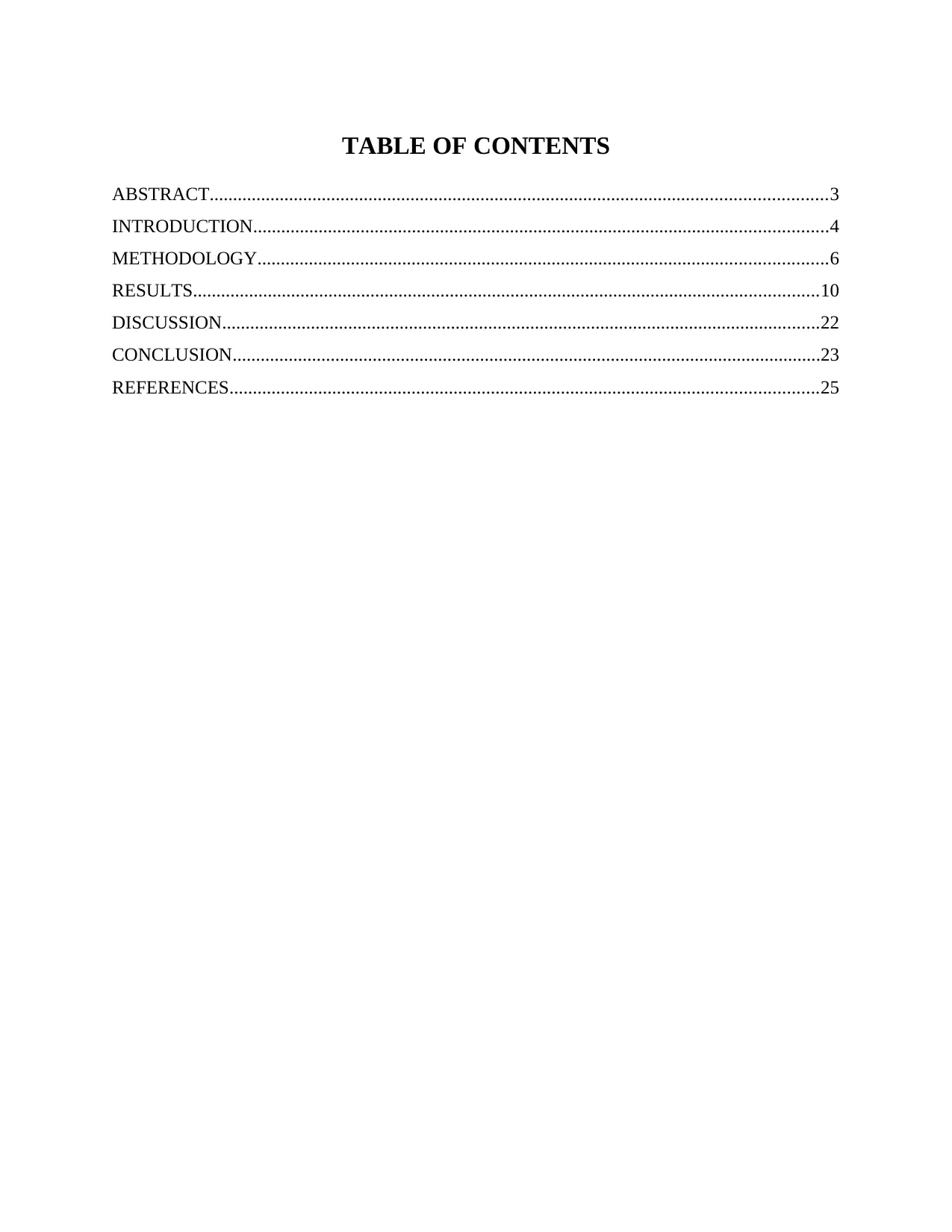
TABLE OF CONTENTS
ABSTRACT....................................................................................................................................3
INTRODUCTION...........................................................................................................................4
METHODOLOGY..........................................................................................................................6
RESULTS......................................................................................................................................10
DISCUSSION................................................................................................................................22
CONCLUSION..............................................................................................................................23
REFERENCES..............................................................................................................................25
ABSTRACT....................................................................................................................................3
INTRODUCTION...........................................................................................................................4
METHODOLOGY..........................................................................................................................6
RESULTS......................................................................................................................................10
DISCUSSION................................................................................................................................22
CONCLUSION..............................................................................................................................23
REFERENCES..............................................................................................................................25
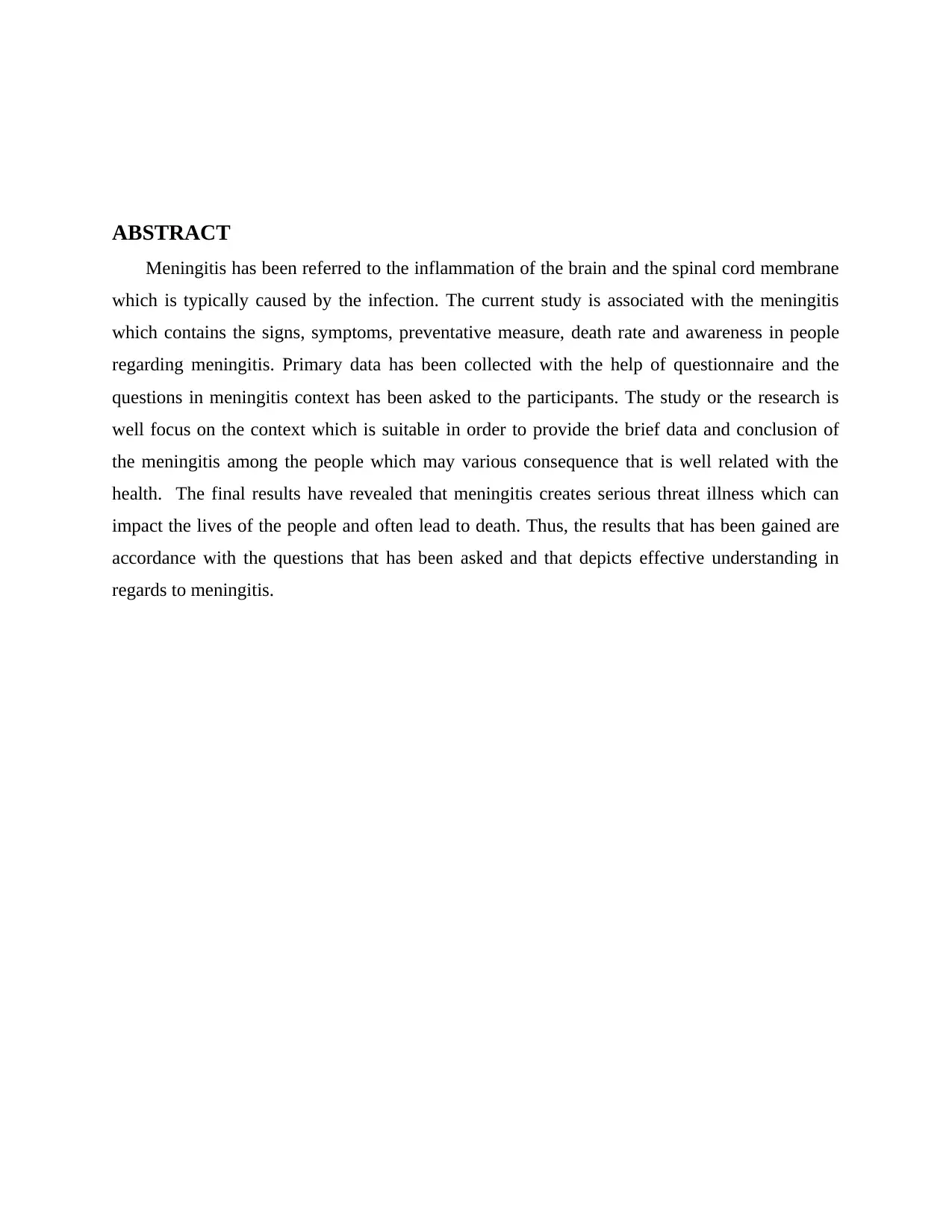
ABSTRACT
Meningitis has been referred to the inflammation of the brain and the spinal cord membrane
which is typically caused by the infection. The current study is associated with the meningitis
which contains the signs, symptoms, preventative measure, death rate and awareness in people
regarding meningitis. Primary data has been collected with the help of questionnaire and the
questions in meningitis context has been asked to the participants. The study or the research is
well focus on the context which is suitable in order to provide the brief data and conclusion of
the meningitis among the people which may various consequence that is well related with the
health. The final results have revealed that meningitis creates serious threat illness which can
impact the lives of the people and often lead to death. Thus, the results that has been gained are
accordance with the questions that has been asked and that depicts effective understanding in
regards to meningitis.
Meningitis has been referred to the inflammation of the brain and the spinal cord membrane
which is typically caused by the infection. The current study is associated with the meningitis
which contains the signs, symptoms, preventative measure, death rate and awareness in people
regarding meningitis. Primary data has been collected with the help of questionnaire and the
questions in meningitis context has been asked to the participants. The study or the research is
well focus on the context which is suitable in order to provide the brief data and conclusion of
the meningitis among the people which may various consequence that is well related with the
health. The final results have revealed that meningitis creates serious threat illness which can
impact the lives of the people and often lead to death. Thus, the results that has been gained are
accordance with the questions that has been asked and that depicts effective understanding in
regards to meningitis.
⊘ This is a preview!⊘
Do you want full access?
Subscribe today to unlock all pages.

Trusted by 1+ million students worldwide
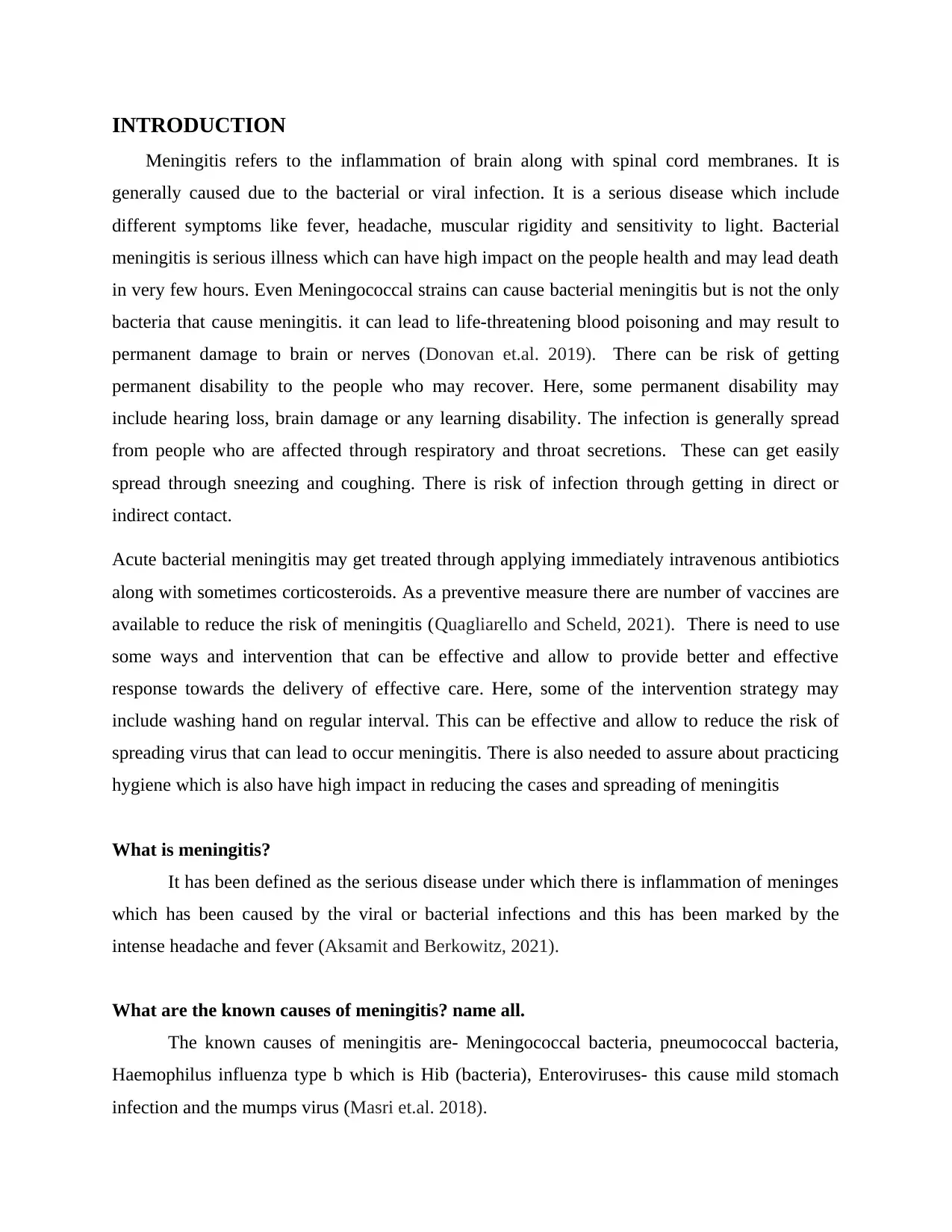
INTRODUCTION
Meningitis refers to the inflammation of brain along with spinal cord membranes. It is
generally caused due to the bacterial or viral infection. It is a serious disease which include
different symptoms like fever, headache, muscular rigidity and sensitivity to light. Bacterial
meningitis is serious illness which can have high impact on the people health and may lead death
in very few hours. Even Meningococcal strains can cause bacterial meningitis but is not the only
bacteria that cause meningitis. it can lead to life-threatening blood poisoning and may result to
permanent damage to brain or nerves (Donovan et.al. 2019). There can be risk of getting
permanent disability to the people who may recover. Here, some permanent disability may
include hearing loss, brain damage or any learning disability. The infection is generally spread
from people who are affected through respiratory and throat secretions. These can get easily
spread through sneezing and coughing. There is risk of infection through getting in direct or
indirect contact.
Acute bacterial meningitis may get treated through applying immediately intravenous antibiotics
along with sometimes corticosteroids. As a preventive measure there are number of vaccines are
available to reduce the risk of meningitis (Quagliarello and Scheld, 2021). There is need to use
some ways and intervention that can be effective and allow to provide better and effective
response towards the delivery of effective care. Here, some of the intervention strategy may
include washing hand on regular interval. This can be effective and allow to reduce the risk of
spreading virus that can lead to occur meningitis. There is also needed to assure about practicing
hygiene which is also have high impact in reducing the cases and spreading of meningitis
What is meningitis?
It has been defined as the serious disease under which there is inflammation of meninges
which has been caused by the viral or bacterial infections and this has been marked by the
intense headache and fever (Aksamit and Berkowitz, 2021).
What are the known causes of meningitis? name all.
The known causes of meningitis are- Meningococcal bacteria, pneumococcal bacteria,
Haemophilus influenza type b which is Hib (bacteria), Enteroviruses- this cause mild stomach
infection and the mumps virus (Masri et.al. 2018).
Meningitis refers to the inflammation of brain along with spinal cord membranes. It is
generally caused due to the bacterial or viral infection. It is a serious disease which include
different symptoms like fever, headache, muscular rigidity and sensitivity to light. Bacterial
meningitis is serious illness which can have high impact on the people health and may lead death
in very few hours. Even Meningococcal strains can cause bacterial meningitis but is not the only
bacteria that cause meningitis. it can lead to life-threatening blood poisoning and may result to
permanent damage to brain or nerves (Donovan et.al. 2019). There can be risk of getting
permanent disability to the people who may recover. Here, some permanent disability may
include hearing loss, brain damage or any learning disability. The infection is generally spread
from people who are affected through respiratory and throat secretions. These can get easily
spread through sneezing and coughing. There is risk of infection through getting in direct or
indirect contact.
Acute bacterial meningitis may get treated through applying immediately intravenous antibiotics
along with sometimes corticosteroids. As a preventive measure there are number of vaccines are
available to reduce the risk of meningitis (Quagliarello and Scheld, 2021). There is need to use
some ways and intervention that can be effective and allow to provide better and effective
response towards the delivery of effective care. Here, some of the intervention strategy may
include washing hand on regular interval. This can be effective and allow to reduce the risk of
spreading virus that can lead to occur meningitis. There is also needed to assure about practicing
hygiene which is also have high impact in reducing the cases and spreading of meningitis
What is meningitis?
It has been defined as the serious disease under which there is inflammation of meninges
which has been caused by the viral or bacterial infections and this has been marked by the
intense headache and fever (Aksamit and Berkowitz, 2021).
What are the known causes of meningitis? name all.
The known causes of meningitis are- Meningococcal bacteria, pneumococcal bacteria,
Haemophilus influenza type b which is Hib (bacteria), Enteroviruses- this cause mild stomach
infection and the mumps virus (Masri et.al. 2018).
Paraphrase This Document
Need a fresh take? Get an instant paraphrase of this document with our AI Paraphraser
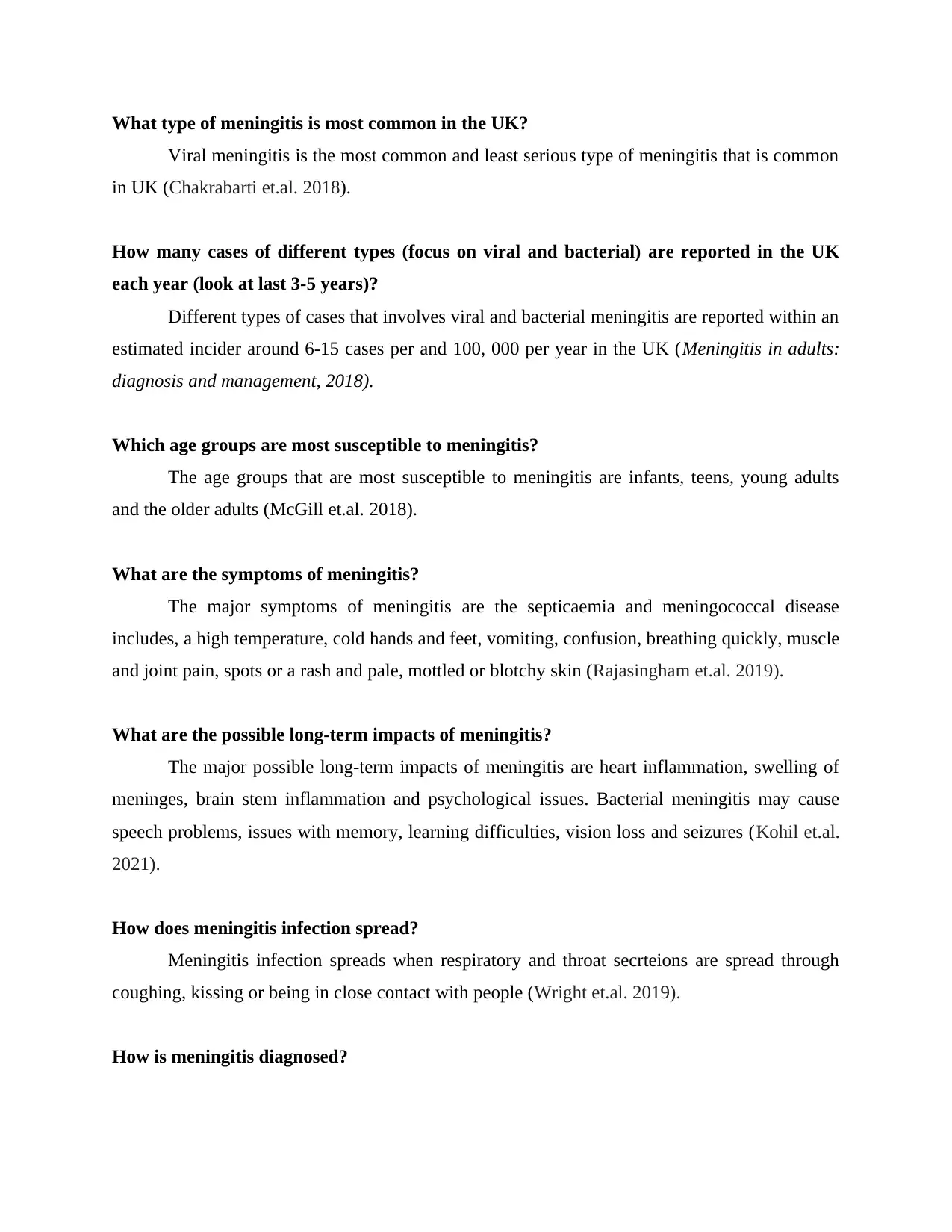
What type of meningitis is most common in the UK?
Viral meningitis is the most common and least serious type of meningitis that is common
in UK (Chakrabarti et.al. 2018).
How many cases of different types (focus on viral and bacterial) are reported in the UK
each year (look at last 3-5 years)?
Different types of cases that involves viral and bacterial meningitis are reported within an
estimated incider around 6-15 cases per and 100, 000 per year in the UK (Meningitis in adults:
diagnosis and management, 2018).
Which age groups are most susceptible to meningitis?
The age groups that are most susceptible to meningitis are infants, teens, young adults
and the older adults (McGill et.al. 2018).
What are the symptoms of meningitis?
The major symptoms of meningitis are the septicaemia and meningococcal disease
includes, a high temperature, cold hands and feet, vomiting, confusion, breathing quickly, muscle
and joint pain, spots or a rash and pale, mottled or blotchy skin (Rajasingham et.al. 2019).
What are the possible long-term impacts of meningitis?
The major possible long-term impacts of meningitis are heart inflammation, swelling of
meninges, brain stem inflammation and psychological issues. Bacterial meningitis may cause
speech problems, issues with memory, learning difficulties, vision loss and seizures (Kohil et.al.
2021).
How does meningitis infection spread?
Meningitis infection spreads when respiratory and throat secrteions are spread through
coughing, kissing or being in close contact with people (Wright et.al. 2019).
How is meningitis diagnosed?
Viral meningitis is the most common and least serious type of meningitis that is common
in UK (Chakrabarti et.al. 2018).
How many cases of different types (focus on viral and bacterial) are reported in the UK
each year (look at last 3-5 years)?
Different types of cases that involves viral and bacterial meningitis are reported within an
estimated incider around 6-15 cases per and 100, 000 per year in the UK (Meningitis in adults:
diagnosis and management, 2018).
Which age groups are most susceptible to meningitis?
The age groups that are most susceptible to meningitis are infants, teens, young adults
and the older adults (McGill et.al. 2018).
What are the symptoms of meningitis?
The major symptoms of meningitis are the septicaemia and meningococcal disease
includes, a high temperature, cold hands and feet, vomiting, confusion, breathing quickly, muscle
and joint pain, spots or a rash and pale, mottled or blotchy skin (Rajasingham et.al. 2019).
What are the possible long-term impacts of meningitis?
The major possible long-term impacts of meningitis are heart inflammation, swelling of
meninges, brain stem inflammation and psychological issues. Bacterial meningitis may cause
speech problems, issues with memory, learning difficulties, vision loss and seizures (Kohil et.al.
2021).
How does meningitis infection spread?
Meningitis infection spreads when respiratory and throat secrteions are spread through
coughing, kissing or being in close contact with people (Wright et.al. 2019).
How is meningitis diagnosed?
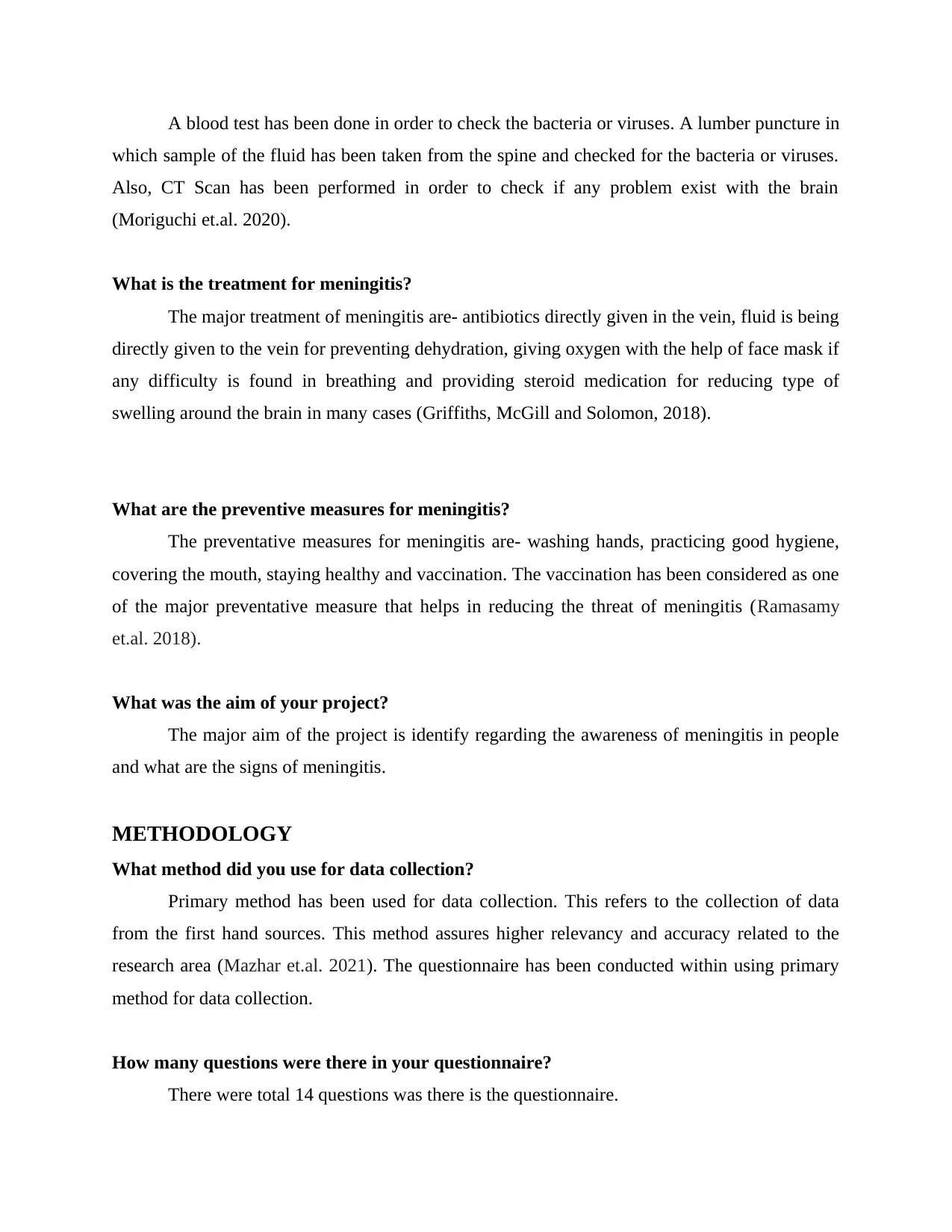
A blood test has been done in order to check the bacteria or viruses. A lumber puncture in
which sample of the fluid has been taken from the spine and checked for the bacteria or viruses.
Also, CT Scan has been performed in order to check if any problem exist with the brain
(Moriguchi et.al. 2020).
What is the treatment for meningitis?
The major treatment of meningitis are- antibiotics directly given in the vein, fluid is being
directly given to the vein for preventing dehydration, giving oxygen with the help of face mask if
any difficulty is found in breathing and providing steroid medication for reducing type of
swelling around the brain in many cases (Griffiths, McGill and Solomon, 2018).
What are the preventive measures for meningitis?
The preventative measures for meningitis are- washing hands, practicing good hygiene,
covering the mouth, staying healthy and vaccination. The vaccination has been considered as one
of the major preventative measure that helps in reducing the threat of meningitis (Ramasamy
et.al. 2018).
What was the aim of your project?
The major aim of the project is identify regarding the awareness of meningitis in people
and what are the signs of meningitis.
METHODOLOGY
What method did you use for data collection?
Primary method has been used for data collection. This refers to the collection of data
from the first hand sources. This method assures higher relevancy and accuracy related to the
research area (Mazhar et.al. 2021). The questionnaire has been conducted within using primary
method for data collection.
How many questions were there in your questionnaire?
There were total 14 questions was there is the questionnaire.
which sample of the fluid has been taken from the spine and checked for the bacteria or viruses.
Also, CT Scan has been performed in order to check if any problem exist with the brain
(Moriguchi et.al. 2020).
What is the treatment for meningitis?
The major treatment of meningitis are- antibiotics directly given in the vein, fluid is being
directly given to the vein for preventing dehydration, giving oxygen with the help of face mask if
any difficulty is found in breathing and providing steroid medication for reducing type of
swelling around the brain in many cases (Griffiths, McGill and Solomon, 2018).
What are the preventive measures for meningitis?
The preventative measures for meningitis are- washing hands, practicing good hygiene,
covering the mouth, staying healthy and vaccination. The vaccination has been considered as one
of the major preventative measure that helps in reducing the threat of meningitis (Ramasamy
et.al. 2018).
What was the aim of your project?
The major aim of the project is identify regarding the awareness of meningitis in people
and what are the signs of meningitis.
METHODOLOGY
What method did you use for data collection?
Primary method has been used for data collection. This refers to the collection of data
from the first hand sources. This method assures higher relevancy and accuracy related to the
research area (Mazhar et.al. 2021). The questionnaire has been conducted within using primary
method for data collection.
How many questions were there in your questionnaire?
There were total 14 questions was there is the questionnaire.
⊘ This is a preview!⊘
Do you want full access?
Subscribe today to unlock all pages.

Trusted by 1+ million students worldwide
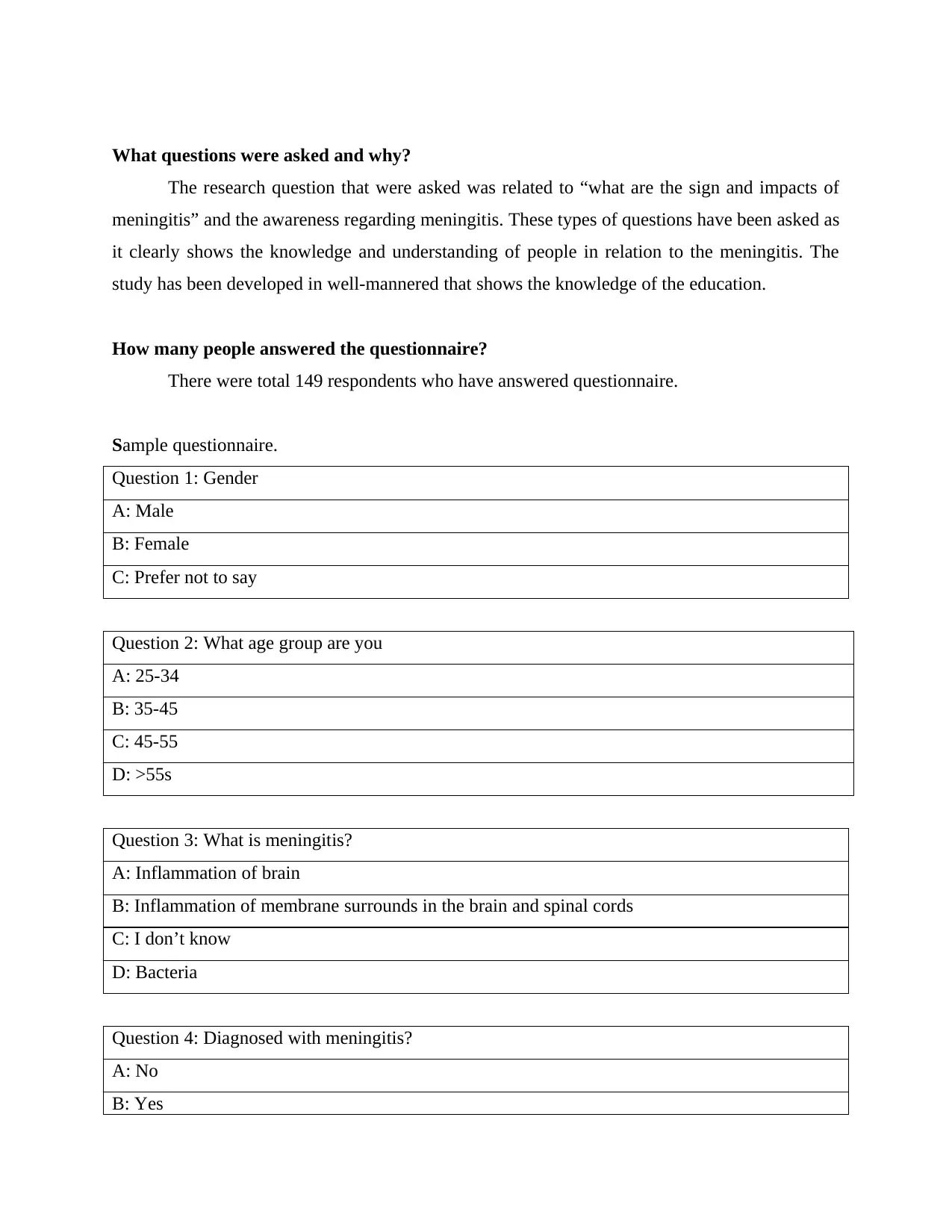
What questions were asked and why?
The research question that were asked was related to “what are the sign and impacts of
meningitis” and the awareness regarding meningitis. These types of questions have been asked as
it clearly shows the knowledge and understanding of people in relation to the meningitis. The
study has been developed in well-mannered that shows the knowledge of the education.
How many people answered the questionnaire?
There were total 149 respondents who have answered questionnaire.
Sample questionnaire.
Question 1: Gender
A: Male
B: Female
C: Prefer not to say
Question 2: What age group are you
A: 25-34
B: 35-45
C: 45-55
D: >55s
Question 3: What is meningitis?
A: Inflammation of brain
B: Inflammation of membrane surrounds in the brain and spinal cords
C: I don’t know
D: Bacteria
Question 4: Diagnosed with meningitis?
A: No
B: Yes
The research question that were asked was related to “what are the sign and impacts of
meningitis” and the awareness regarding meningitis. These types of questions have been asked as
it clearly shows the knowledge and understanding of people in relation to the meningitis. The
study has been developed in well-mannered that shows the knowledge of the education.
How many people answered the questionnaire?
There were total 149 respondents who have answered questionnaire.
Sample questionnaire.
Question 1: Gender
A: Male
B: Female
C: Prefer not to say
Question 2: What age group are you
A: 25-34
B: 35-45
C: 45-55
D: >55s
Question 3: What is meningitis?
A: Inflammation of brain
B: Inflammation of membrane surrounds in the brain and spinal cords
C: I don’t know
D: Bacteria
Question 4: Diagnosed with meningitis?
A: No
B: Yes
Paraphrase This Document
Need a fresh take? Get an instant paraphrase of this document with our AI Paraphraser
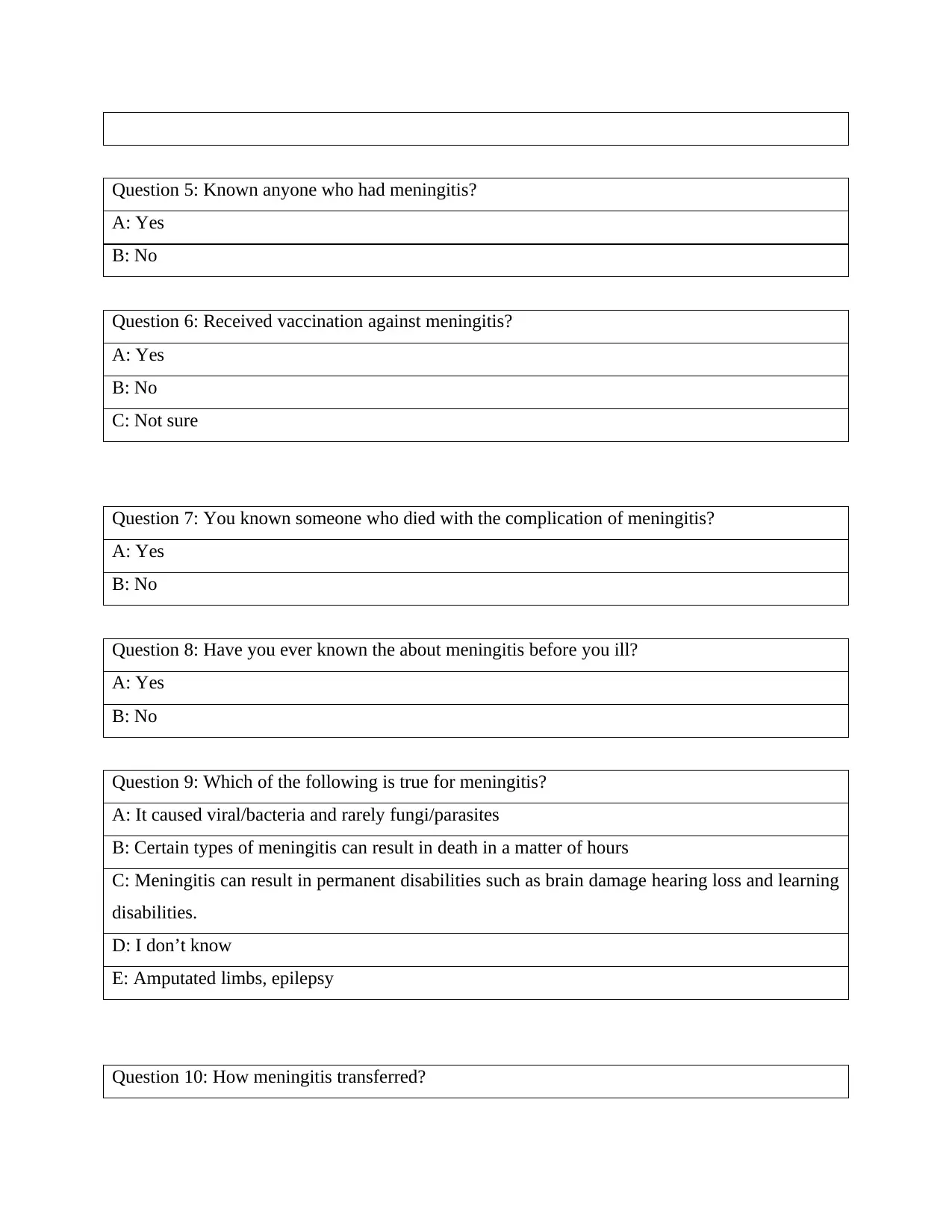
Question 5: Known anyone who had meningitis?
A: Yes
B: No
Question 6: Received vaccination against meningitis?
A: Yes
B: No
C: Not sure
Question 7: You known someone who died with the complication of meningitis?
A: Yes
B: No
Question 8: Have you ever known the about meningitis before you ill?
A: Yes
B: No
Question 9: Which of the following is true for meningitis?
A: It caused viral/bacteria and rarely fungi/parasites
B: Certain types of meningitis can result in death in a matter of hours
C: Meningitis can result in permanent disabilities such as brain damage hearing loss and learning
disabilities.
D: I don’t know
E: Amputated limbs, epilepsy
Question 10: How meningitis transferred?
A: Yes
B: No
Question 6: Received vaccination against meningitis?
A: Yes
B: No
C: Not sure
Question 7: You known someone who died with the complication of meningitis?
A: Yes
B: No
Question 8: Have you ever known the about meningitis before you ill?
A: Yes
B: No
Question 9: Which of the following is true for meningitis?
A: It caused viral/bacteria and rarely fungi/parasites
B: Certain types of meningitis can result in death in a matter of hours
C: Meningitis can result in permanent disabilities such as brain damage hearing loss and learning
disabilities.
D: I don’t know
E: Amputated limbs, epilepsy
Question 10: How meningitis transferred?
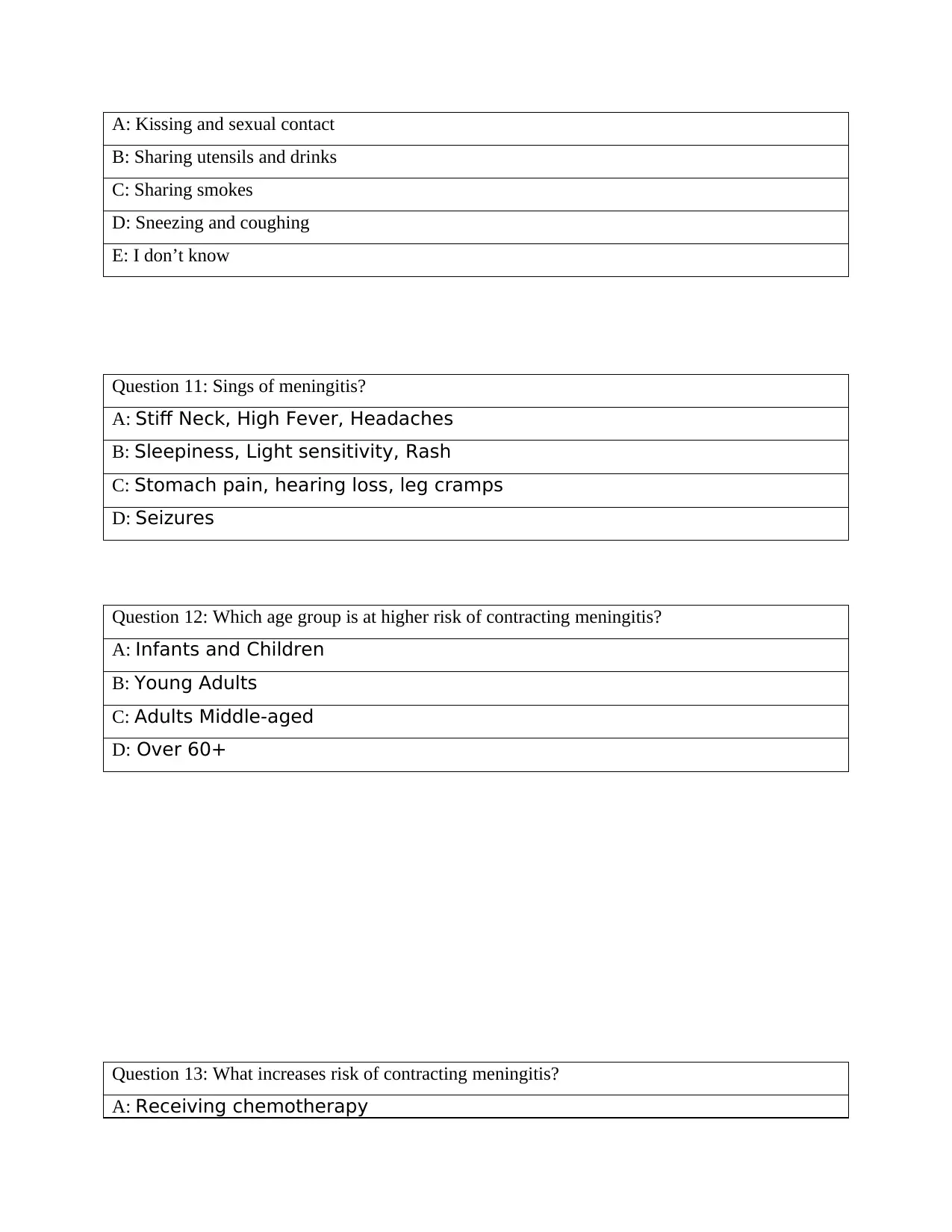
A: Kissing and sexual contact
B: Sharing utensils and drinks
C: Sharing smokes
D: Sneezing and coughing
E: I don’t know
Question 11: Sings of meningitis?
A: Stiff Neck, High Fever, Headaches
B: Sleepiness, Light sensitivity, Rash
C: Stomach pain, hearing loss, leg cramps
D: Seizures
Question 12: Which age group is at higher risk of contracting meningitis?
A: Infants and Children
B: Young Adults
C: Adults Middle-aged
D: Over 60+
Question 13: What increases risk of contracting meningitis?
A: Receiving chemotherapy
B: Sharing utensils and drinks
C: Sharing smokes
D: Sneezing and coughing
E: I don’t know
Question 11: Sings of meningitis?
A: Stiff Neck, High Fever, Headaches
B: Sleepiness, Light sensitivity, Rash
C: Stomach pain, hearing loss, leg cramps
D: Seizures
Question 12: Which age group is at higher risk of contracting meningitis?
A: Infants and Children
B: Young Adults
C: Adults Middle-aged
D: Over 60+
Question 13: What increases risk of contracting meningitis?
A: Receiving chemotherapy
⊘ This is a preview!⊘
Do you want full access?
Subscribe today to unlock all pages.

Trusted by 1+ million students worldwide
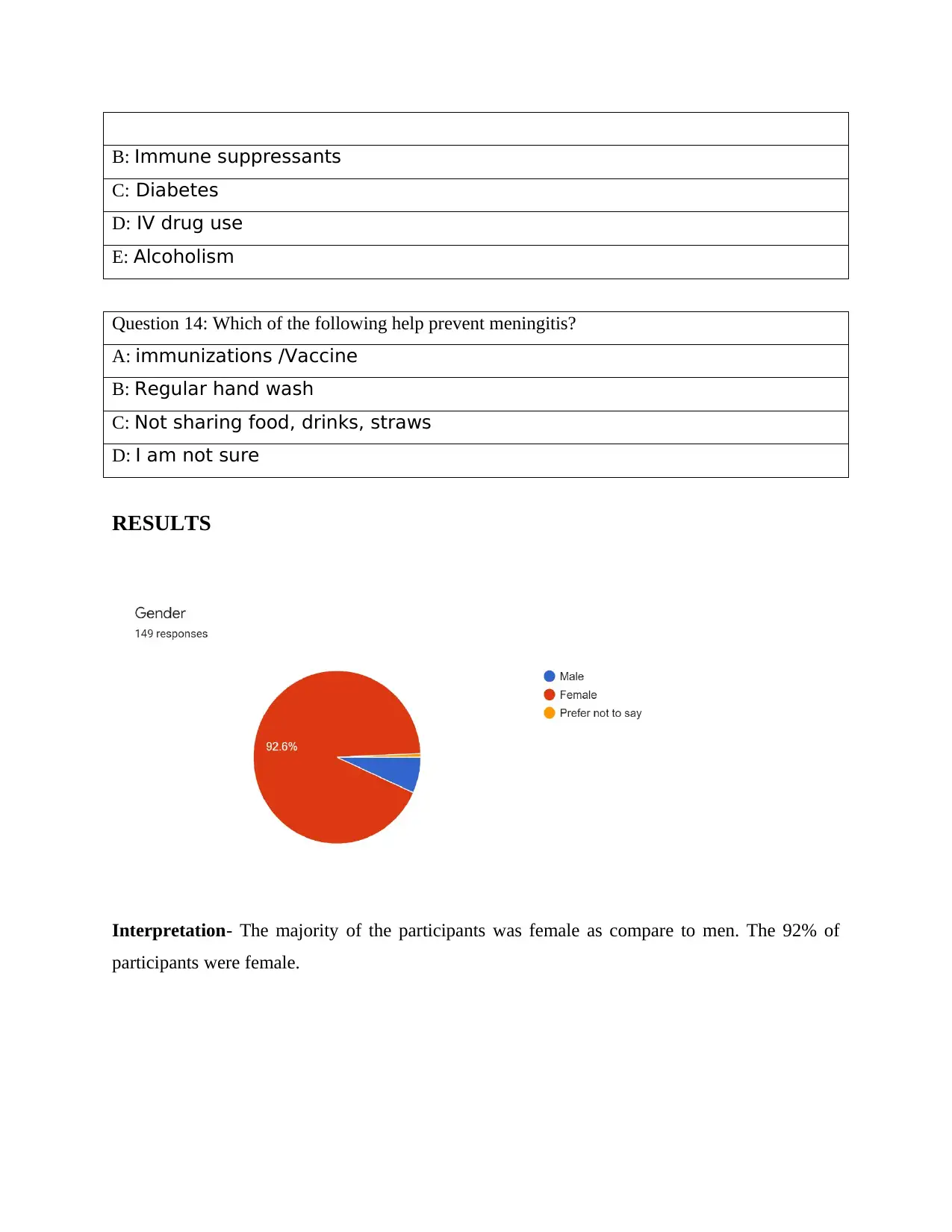
B: Immune suppressants
C: Diabetes
D: IV drug use
E: Alcoholism
Question 14: Which of the following help prevent meningitis?
A: immunizations /Vaccine
B: Regular hand wash
C: Not sharing food, drinks, straws
D: I am not sure
RESULTS
Interpretation- The majority of the participants was female as compare to men. The 92% of
participants were female.
C: Diabetes
D: IV drug use
E: Alcoholism
Question 14: Which of the following help prevent meningitis?
A: immunizations /Vaccine
B: Regular hand wash
C: Not sharing food, drinks, straws
D: I am not sure
RESULTS
Interpretation- The majority of the participants was female as compare to men. The 92% of
participants were female.
Paraphrase This Document
Need a fresh take? Get an instant paraphrase of this document with our AI Paraphraser
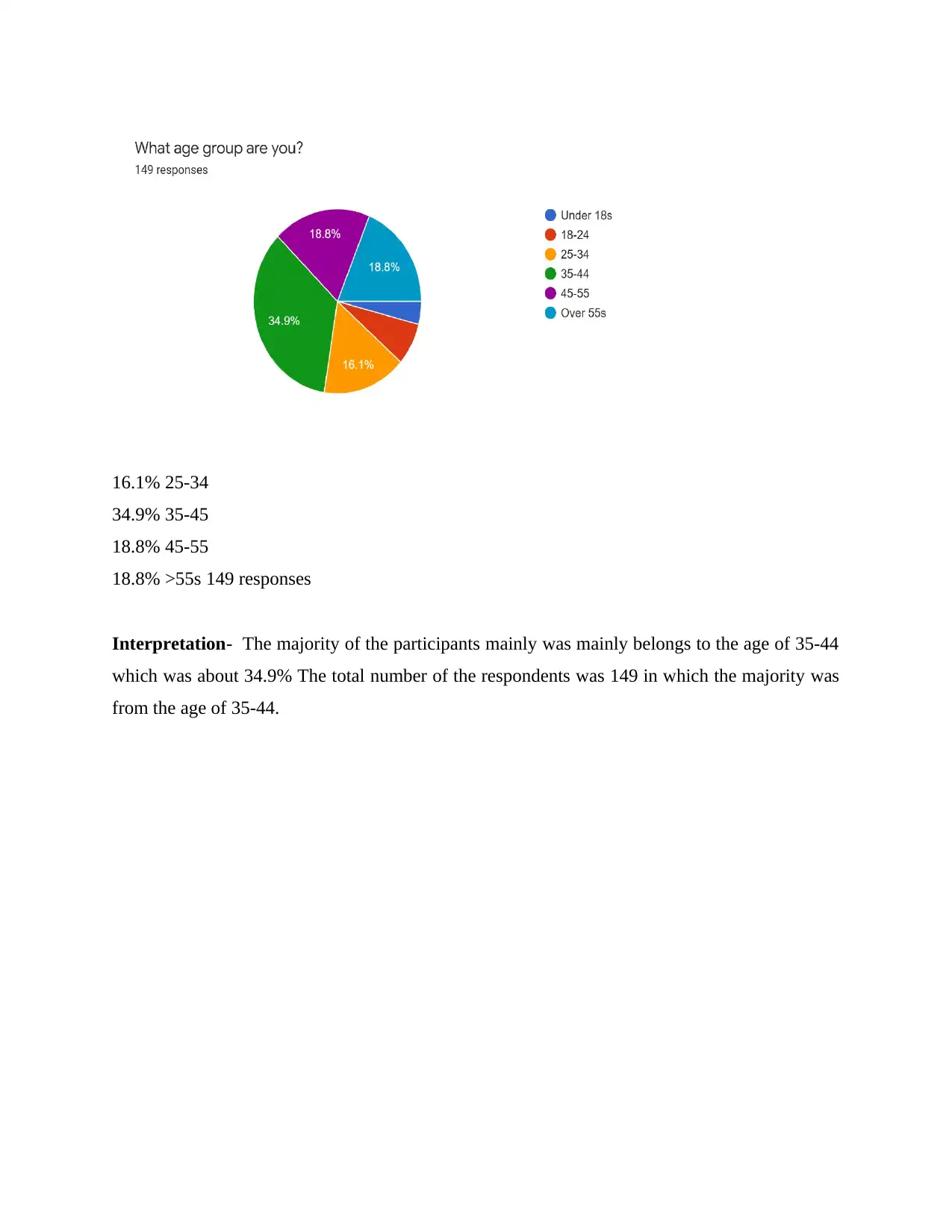
16.1% 25-34
34.9% 35-45
18.8% 45-55
18.8% >55s 149 responses
Interpretation- The majority of the participants mainly was mainly belongs to the age of 35-44
which was about 34.9% The total number of the respondents was 149 in which the majority was
from the age of 35-44.
34.9% 35-45
18.8% 45-55
18.8% >55s 149 responses
Interpretation- The majority of the participants mainly was mainly belongs to the age of 35-44
which was about 34.9% The total number of the respondents was 149 in which the majority was
from the age of 35-44.
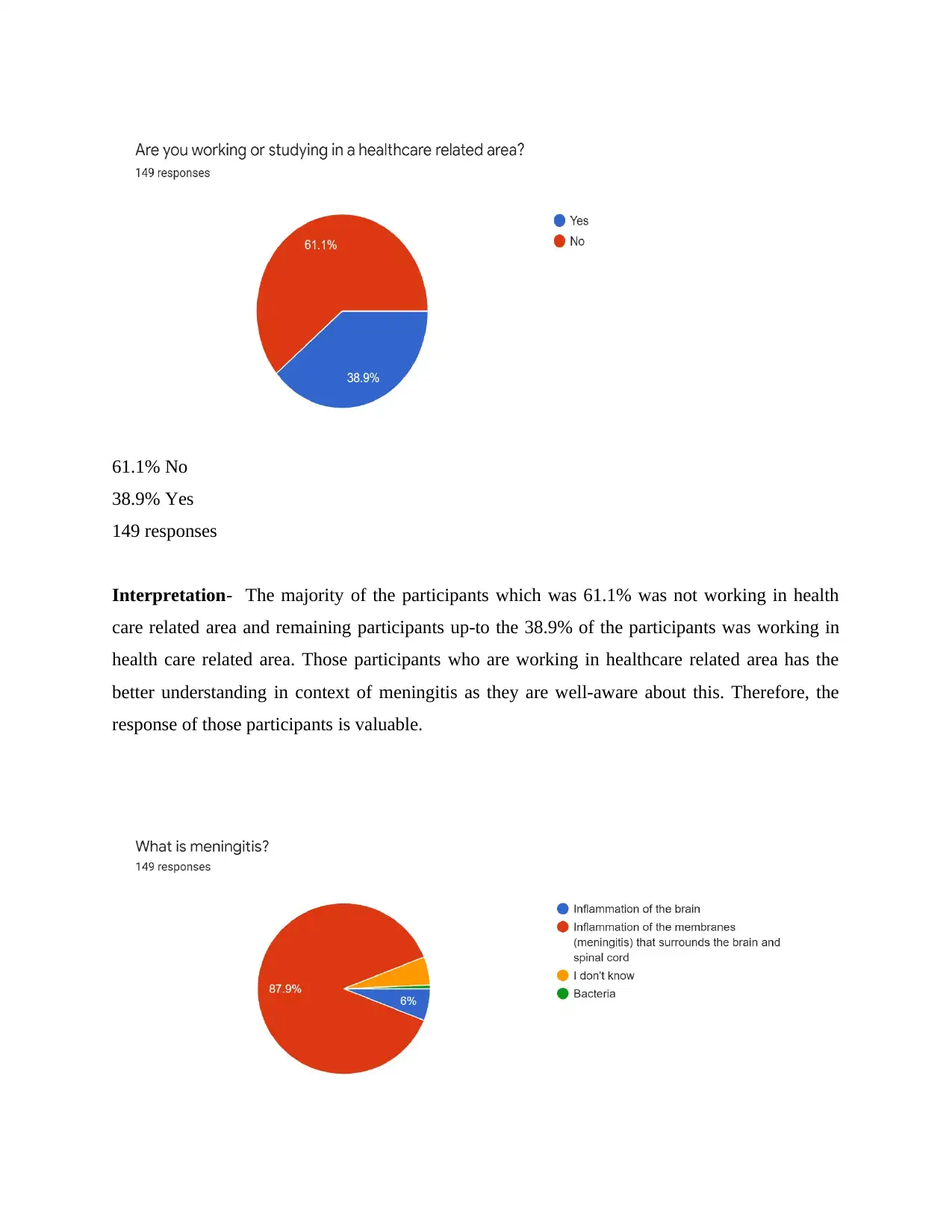
61.1% No
38.9% Yes
149 responses
Interpretation- The majority of the participants which was 61.1% was not working in health
care related area and remaining participants up-to the 38.9% of the participants was working in
health care related area. Those participants who are working in healthcare related area has the
better understanding in context of meningitis as they are well-aware about this. Therefore, the
response of those participants is valuable.
38.9% Yes
149 responses
Interpretation- The majority of the participants which was 61.1% was not working in health
care related area and remaining participants up-to the 38.9% of the participants was working in
health care related area. Those participants who are working in healthcare related area has the
better understanding in context of meningitis as they are well-aware about this. Therefore, the
response of those participants is valuable.
⊘ This is a preview!⊘
Do you want full access?
Subscribe today to unlock all pages.

Trusted by 1+ million students worldwide
1 out of 26
Related Documents
Your All-in-One AI-Powered Toolkit for Academic Success.
+13062052269
info@desklib.com
Available 24*7 on WhatsApp / Email
![[object Object]](/_next/static/media/star-bottom.7253800d.svg)
Unlock your academic potential
Copyright © 2020–2025 A2Z Services. All Rights Reserved. Developed and managed by ZUCOL.





